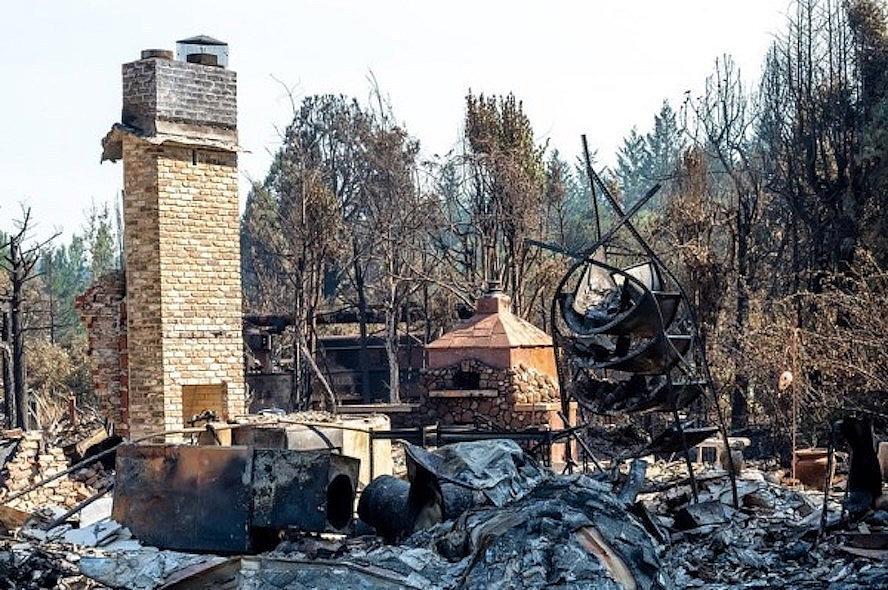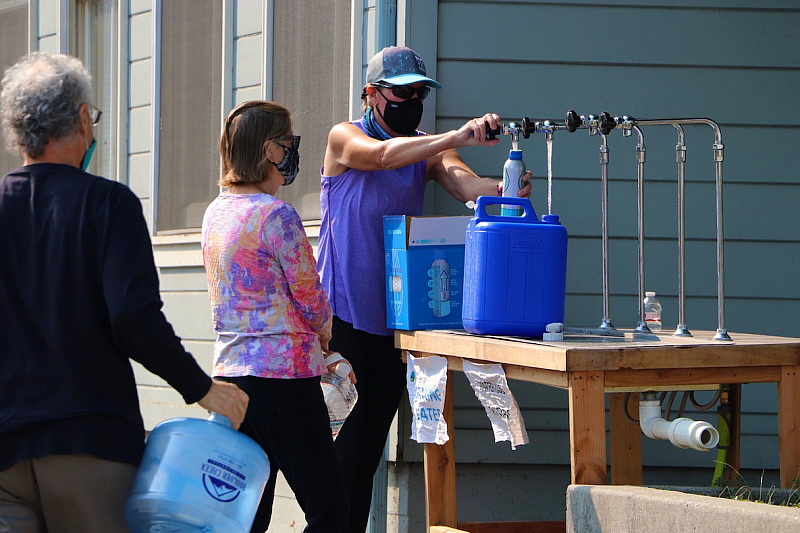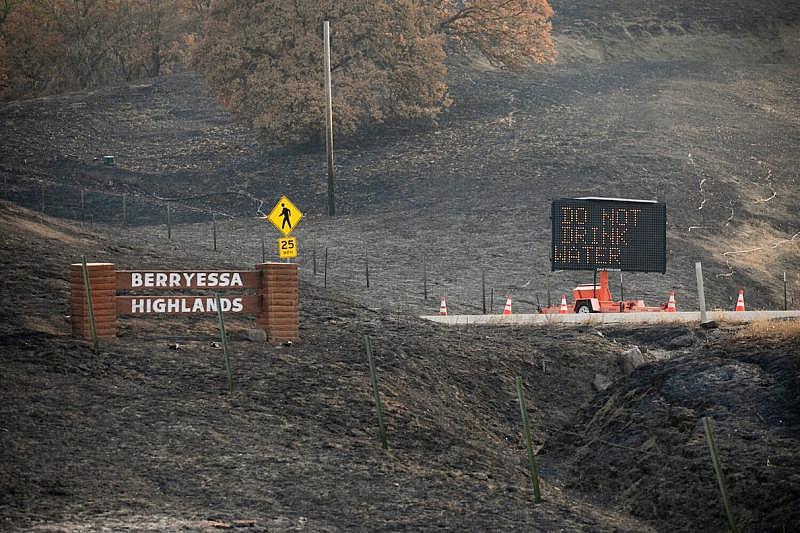‘The aftermath’: Lightning complex fires also seriously damaged drinking water systems
This story was produced as a larger project by Kiley Russell for the Impact Fund.
His other stories include:
Pandemic could complicate implementation of new state drinking water fund
Regulators approve spending to save state’s failing drinking water systems
Water Agencies And Advocates Join In Seeking Federal Funds To Reduce Water Costs
Rural California communities struggle to provide clean drinking water

The CZU Lightning Complex fires not only destroyed hundreds of homes, but also damaged water systems operated by the San Lorenzo Valley Water District and tainted drinking water for residents.
(Photo courtesy of Cal OES)
As the CZU Lightning Complex fire bore down on Gail Mahood’s tree-shrouded Felton neighborhood in August, she gathered what possessions she could and fled.
“As I drove away and saw how fast the fire was moving, I didn’t have much hope for my home,” Mahood recalled.
Thankfully, fire crews saved the little community of 20 or so houses, stopping the blaze within a half-mile of Mahood’s home in the Santa Cruz Mountains, but the pipes that delivered drinking water from a spring just up the hill were completely destroyed.
“There were a lot of people who didn’t have water for a long time,” Mahood said.
In fact, much of the drinking water system operated by the San Lorenzo Valley Water District that serves Mahood’s neighborhood, along with some 7,100 other households, was damaged or destroyed.
Over the past five years or so, hundreds of California drinking water systems have suffered similar fates while struggling with the impacts of the state’s increasingly intense climate-driven wildfires.
In 2020 alone, 250 water systems were either damaged by fire or were subject to fire-related public safety power shutoffs, according to Stefan Cajina, who leads the Drinking Water Division for the State Water Resources Control Board’s North Coast Section.
The damage these systems endured ranges from the complete destruction of treatment plants, office buildings and distribution pipelines to water supplies contaminated with volatile organic compounds, including benzene, the “bellwether” chemical most associated with fire damage.
Stefan Cajina of the State Water Resources Control Board.
“It’s costly and it is capable of doing real damage to a community’s ability to exist,” said Cajina, who oversees about 20% of the state’s drinking water systems. “You can’t have a community without an intact water supply.”
Last year, several water systems serving communities around the Bay Area suffered the effects of three massive wildfires sparked by a rare cluster of late-summer thunderstorms that swept across Northern California.
Several of these fires merged into three separate “megafires” that bracketed the Bay Area — the CZU, LNU and SCU lightning complex fires, which burned more than 843,000 acres in 13 counties and killed seven people.
The impact of wildfires on drinking water systems
“Cleary we are starting to see fire impacts in neighborhoods that were not thought of as at risk, seeing a speed and level of destruction we have not seen previously,” Cajina said. “It looks like this is a type of impact that is here to stay, unfortunately.”
In the immediate aftermath of the lightning complex fires and in the weeks and months that followed, it became clear that one of the biggest obstacles to recovery efforts was the damage done to drinking water systems.
In the San Lorenzo Valley Water District’s service area, which was entirely evacuated ahead of the blaze, 5 to 7 miles of above-ground plastic distribution pipes burned, along with creek diversions, storage tanks and hundreds of homes.
Four of the five largest fires in California history occurred in 2020. One, the Mendocino Complex, was in 2018. (Credit: Cal Fire; data as of Sept. 25, 2020)
This resulted in what the district called “widespread” depressurization of the system.
The burned plastic and depressurization led to benzene and other volatile organic compounds contaminating parts of the system in some outlying reaches of the service area and all residents were warned not to drink the water, even after boiling it.
The damage was bad but it could have been much, much worse were it not for the efforts of the water system’s general manager and operations manager, said Mahood, who in November was elected to the San Lorenzo Valley Water District’s Board of Directors.
These two staffers realized that by closing valves to pipelines leading off from the main service lines, they could effectively protect the central part of the distribution system from depressurization.
This kept the water flowing for the firefighting effort and prevented “the back-syphoning effect” that would have drawn contaminants into the central part of the system, Mahood said.
“They were really quite heroic,” she said. “From Boulder Creek you could see a towering line of flames. It was no joke — they were putting their lives on the line to keep the water there so the firefighters could try to save the town and as many homes as they could.”
Still, the damage was done and it wasn’t until Oct. 23 that the final “do not drink/do not boil” notice was canceled, and Mahood said the ultimate repair bill could run from $10 million to $20 million.
Gail Mahood of the San Lorenzo Valley Water District.
“The fragility of the water systems in these rural and semi-rural areas stems from the fact that they are all under-capitalized,” she said. “A lot of our customers are not wealthy people. Unfortuna
In the meantime, almost half of the system’s water sources — nearby creeks that run down the east side of Ben Lomond Mountain — are unavailable because the intake equipment burned.tely, the rate payers will have to support some of this.”
That means almost all the drinking water is being drawn from wells.
“The problem is that we don’t want to do that for a long time because then you draw down the aquifers,” Mahood said.
And while the fire itself was bad enough, the fact that it denuded hillsides of vegetation around the water district’s surface water sources is cause for lingering concern, especially in the winter months when rain is liable to wash ash, fire-damaged soil and other detritus into local streams where it can clog or damage intakes.
The CZU Lightning Complex Fire knocked out the water system that served more than 10,000 people who lived in the San Lorenzo Valley Water District. (Photo courtesy of firehouse.com)
Newsha Ajami, director of Urban Water Policy at the Stanford Woods Institute for the Environment, said researchers are still working to understand the way megafires and post-fire runoff effect drinking water systems.
“This is something that everyone is trying to wrap their heads around,” Ajami said. “It’s a learning curve.”
While Western states have always braced for seasonal fire events, things have clearly become much more worrisome over the past five years or so.
Climate change, urban encroachment into wild spaces and forest management practices have all contributed to intensifying impacts of wildfires on water systems throughout the region, Ajami said.
“It’s a combination,” she said. “You have these landscapes, these watershed areas burning and if there is development in that area, then you’re dealing with a lot of toxins and chemical compounds that after the fire can end up in the watershed and then get washed off into our water bodies if we don’t clean it up.”
“As soon as it burns, you now have a totally different landscape that you’re dealing with,” Ajami said. “When you have a lot of pretty mature landscapes, the trees and shrubbery and all that sort of slows down the water and allows some of that water to infiltrate the soil.Additionally, drinking water systems are built on the assumption that the immediate landscape is basically unchanging, that water flows down hillsides in certain volumes and at certain rates of speed.
“If the whole landscape is burned, that doesn’t function anymore,” she said. “It is very important to highlight the water-related issues with fire because so often they are forgotten. These lingering impacts are still unwinding.”
Water systems serving Lake Berryessa communities
Newsha Ajami of the Stanford Woods Institute for the Environment.
That’s a lesson Napa County Public Works Deputy Director Phillip Miller has learned in his role managing water systems serving the small communities of Berryessa Highlands and Berryessa Estates, which draw their water from Lake Berryessa on the border of Lake and Napa counties.
While neither of the water systems were directly damaged by fire, both were used so extensively by crews battling the LNU Lightning Complex fire that they essentially ran dry, leading both to depressurize.
The pipes leading to those homes weren’t made of plastic, however, so the system wasn’t contaminated with benzene or other volatile organic compounds, Miller said.Also, in Berryessa Highlands, water was leaking from plumbing destroyed by flames that leveled roughly 100 homes.
Still, because the systems depressurized, they had to be treated as if they were contaminated and completely flushed with fresh water.
For about a month, Berryessa Estates customers were required to boil their tap water before using it and Berryessa Highlands was under a “do not drink/do not boil” order.
A sign warning residents not to drink the water is posted along Steele Canyon Road at the entrance to Berryessa Highlands on Sept. 21, 2020. (File photo courtesy of Anne Wernikoff/CalMatters)
Some of the biggest challenges came after the fires, which essentially burned around the entire perimeter of Lake Berryessa.
“Depending on how hot the fire gets in a particular area, it essentially waterproofs the soil surface,” Miller said. “That’s why you get these flash floods after big burns.”
That means water is running unchecked into the lake, flushing ash and soot from the burn areas.
“It clogs up filters that would have normally worked fine, but the ash is so fine, it gunks everything up,” Miller said. “You’ve got to get down there with pumps and vacuums and literally suck the gunk out of pipes.”
He also said this runoff, which can contain nitrogen and phosphorus from fire retardants, tends to encourage algae blooms.
“The algae love it. The impacts of the algae and aquatic weeds have gotten much, much, much worse,” Miller said. “We found that our treatment plant really wasn’t capable of dealing with the algae problem.”
‘It tastes bad, it smells bad’
And while the water is safe to drink, people have complained about its taste and odor.
“It makes people afraid of drinking their water,” Miller said. “It tastes bad, it smells bad, it tastes musty and that makes people worry about the quality of their water.”
Perhaps the most concerning effect of the latest fires is the fact that a significant number of Berryessa Highland residents might never move back, leading to a permanent loss of revenue for the little water district.
“You’ve got a small system where one-third of the customers are now gone,” Miller said. “It’s like, holy crap, now what? We’re going to be dealing with that in the coming years. The county is going to have to make some decisions about what are we going to do with these people.
“The aftermath is a story that’s just beginning to be told,” he said.
* Kiley Russell reported this story with support from the 2019 Impact Fund, a program of the USC Annenberg Center for Health Journalism.
[This story was originally published by Local News Matters.]
Did you like this story? Your support means a lot! Your tax-deductible donation will advance our mission of supporting journalism as a catalyst for change.
